Quest for saffron leads to Spain’s charming Consuegra, Don Quixote and centuries of tradition
by Janet Podolak · Published · Updated

This closeup of a saffron flower reveals the pollen-laden red and orange stamens embraced by bright purple petals. Janet Podolak
I’d hoped a visit to Consuegra for the annual Saffron Rose Festival would help me learn why this spice is considered more valuable than gold.
Not far from Toledo, directly south of Madrid, the town has a population of only about 10,000. So I was astonished to discover how well saffron is celebrated here in food, music and dance, drawing people from near and far away during the final weekend of October. The number and quality of restaurants also was a big surprise, considering the size of Consuegra.
Like many other small-town festivals, its main square was filled with booths showcasing saffron and other regional products and hosting contests, such as the monda, a competition to see how quickly saffron stamens can be removed from the flowers.

Saffron blossoms must be harvested by hand during the two weeks they bloom in late October.
Janet Podolak
After the low-growing flowers are picked, the three orange/red stamens of the flower are plucked from each, then dried to become saffron. More than 256,000 flowers must be picked to accumulate 1 kilo (2.2 pounds) of saffron, making it the most valuable spice in the world.

A saffron picker indicates the three stamens on each bloom that are picked, then dried, to become the world’s most valuable spice.
Janet Podolak
One has to wonder who ever first thought of doing this.
To witness the harvest, done by hand one flower at a time, gives a greater appreciation for the backbreaking work. Iran, where the climate is similar to this part of Spain, grows 90 percent of the world’s saffron. But because the U.S. doesn’t trade with Iran, saffron from Spain is the rule in the United States.
Our visit to the saffron fields of the Lozano family was followed by a luncheon of dishes all made with saffron, called azafran in Spain.Restaurante El Alfar occupies three low, white-washed, tile-roofed adobe buildings with porches; they sit around a shady courtyard in Consuegra built over a one-time pottery, which itself was built over a first-century Roman circus. It is staffed mostly with disabled folks, from cooks to servers, aiming to go beyond just integrating them into society by helping them learn careers and normalizing their lives.
Saffron is used extensively in El Alfar dishes during the saffron season, but the extraordinary kitchen also rewards diners with foods that include smoked sardines, black garlic aioli and the local manchego cheese in many forms, such as in a ratatouille.
I was really impressed with the smoked venison stew with almonds, the roasted red pepper salad called asadillo and a sophisticated but down-home salt cod saffron tempura.
And El Alfar’s migas de pastor is not to be missed. This Spanish peasant dish combines day-old bread crumbs, fried with garlic, saffron, cumin, paprika, parsley and prosciutto and has a taste and texture that greatly transcends its modest ingredients.
Saffron, I soon discovered, straddles the sweet and savory, is deliciously fragrant, sweetly floral in taste, and adds lovely and surprising nuances to many foods. Threads, as the saffron stamens are called, often are infused in liquid.
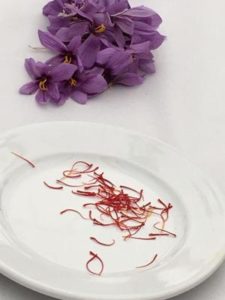
Stamens plucked from their saffron blooms are placed on a plate so they can be counted for the monda competition.
Janet Podolak
It’s used in breads, honey, sausages, rice and cheese. Saffron is said to protect the liver and digestive system, promote night vision, have antidepressant properties, combat fatigue, be good for memory, lower cholesterol and aid with both Type 2 diabetes and gluten intolerance.
The addition of cumin in dishes served at El Alfar recalls the Moorish influence still prominent in Spain after 700 years of occupation by the Moors, which ended in 1492. In today’s Spain, Moroccans are fully integrated and remain the country’s largest Muslim population.
El Alfar was just one of the many fine restaurants we discovered in Consuegra. One of them — Gastromolino — is inside one of the town’s landmark windmills, and a winding stair climb is needed to reach the dining room. All 12 windmills are named.
The old windmills, which line a ridge line on Calerico Hill, play a symbolic role in “Don Quixote,” written in the 1600s by Miguel Cervantes. Literary experts have said that, in Don Quixote’s mind, they represented the destruction of the past and the loss of knightly values — values that no longer existed but which he was trying to hold onto.
“Don Quixote” is considered by some as the best novel ever written. In the 1970s, it was made into “The Man of LaMancha” musical.
Also on the ridge line is a castle dating to 1183, largely restored and open for visits. Destroyed by Napoleon’s troops in 1813, its painstaking rehabilitation continues. The castle defended the village for centuries but also protected its supply of water — a necessity in this arid climate where only inches of rain fall each year. During the saffron festival, one room of the castle had mounds of saffron blossoms on tables and was open for visitors to try their hand at plucking the stamens.
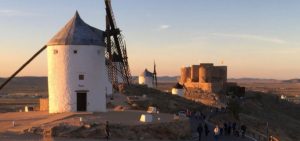
Windmills along the ridgeline above Consuegra flank a 12th-century castle, now restored.
Janet Podolak
During my visit in October, the windmills were in use to demonstrate the grinding of grain, and the hillside leading to them provided seating for hundreds on hand to see folk dancing by costumed dancers from different provinces of the Castilla-LaMancha region in Spain. The dancing was one of the many Saffron Festival attractions.
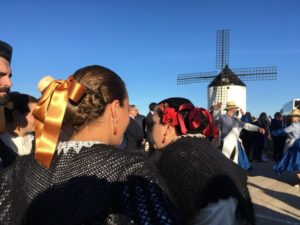
A windmill overlooks dancers in the traditional costumes of their villages who watch as other dancers perform.
Janet Podolak
Back in town, we strolled from our lodging at the charming La Vida de Antes hotel to the town square, where the town hall dates to 1670. On one side of the square is the 17th-century Corredores, with its second floor surrounded by a balcony. Off that balcony is a small museum in which the area’s history is traced by artefacts dating to the first and second centuries. The displays are interpreted in English as well as Spanish — something not found in many museums in larger Spanish cities.

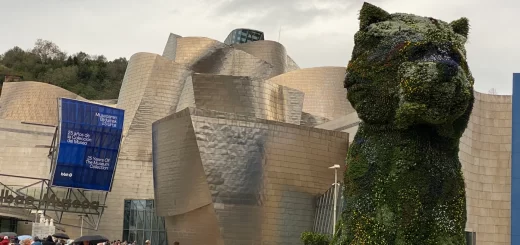

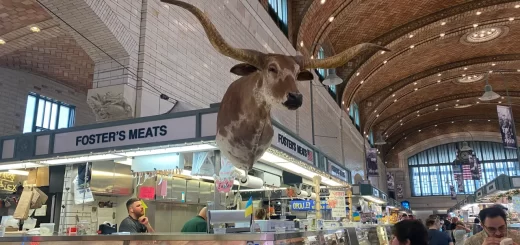
Recent Comments